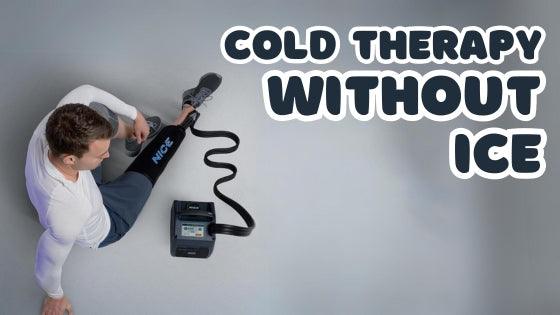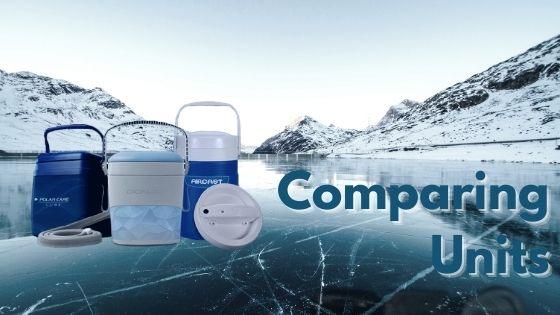Benefits of Cold Therapy for Athletes

Recover Smarter, Train Harder
For performance-driven athletes, training often pushes the body into a state of supercompensation—you stress your muscles so they adapt and become stronger. But that edge comes with soreness, micro-trauma, and fatigue. Cryotherapy, or cold therapy, is one of the most effective tools athletes have to manage that pain, speed recovery, and stay in the game.
Many high schools, colleges, and pro training centers maintain ice baths and cold systems not as luxuries, but as essential recovery tools. It’s no coincidence: cold therapy helps blunt inflammation, alleviate discomfort, and support tissue repair without reliance on medications.
What Cold Therapy Does for Sore Muscles
Whereas heat therapy stimulates blood flow and “open up” tissues, cold therapy does the reverse—and that’s precisely what your body needs after intense exertion or injury.
-
Vasoconstriction: Cold causes blood vessels to narrow, reducing the influx of fluid and inflammatory markers into overworked muscle.
-
Reduced metabolic demand: Cold lowers the metabolic rate of cells in the stressed area, limiting secondary injury (hypoxic or ischemic damage).
-
Analgesic effect: The numbing impact of cold blocks pain signals and soothes nerve endings.
Immediately after applying cold, you’ll often notice swelling slow or recede. That effect is critical: once inflammation spirals out of control, recovery becomes slower and more painful. By constraining vascular leakage and fluid buildup, cold therapy helps tissues reset faster and resume optimal function.
This mechanism is why devices like Game Ready—which combine cold with intermittent compression—are favored in elite athletic settings. The Game Ready GRPro 2.1, for example, integrates active cooling and pneumatic compression with adjustable controls, outperforming static ice therapy in many clinical studies. (Game Ready) Its wrap designs also ensure anatomically correct coverage, meaning more effective cooling across complicated joints. (Game Ready)
Cold Therapy Options for Athletes
Athletes today have multiple cold therapy modalities at their disposal. Understanding trade-offs helps you choose what’s right for your sport and schedule.
-
Ice Packs / Gel Packs
-
Pros: Low cost, easy access
-
Cons: Short duration, poor conformity to joint geometry
-
-
Cold Therapy Machines (Circulating Systems)
-
These systems pump chilled water from a reservoir into a wrap or pad that conforms to the injury area. The continuous circulation maintains a stable cold temperature longer than static packs.
-
Many sport and rehab professionals rely on such systems because they permit extended therapy sessions with consistent cold delivery.
-
-
Combined Cold + Compression Devices
- This is considered best-in-class for athletic recovery. The Game Ready GRPro system is a notable example, using intermittent pneumatic compression paired with cold therapy for superior edema control.
- Some multi-mode units (e.g. Game Ready’s MED4 Elite) also include heat and contrast modes for later-stage rehab.
On SourceColdTherapy, you’ll find a broad selection of cold therapy units, wraps, and cold packs from top brands like Breg, Aircast, DonJoy, and Game Ready. (SourceColdTherapy) These include models suited for athletic use, with features like long runtime and strong flow control.
When (and How Long) to Use Cold Therapy
-
Timing is crucial. Apply cold therapy during or immediately following the inflammatory phase—ideally within the first few hours of exertion or injury.
-
Session duration: Use cold therapy in intervals of 10 to 20 minutes. Too long may overcool tissues.
-
Repeat cycles: Use multiple sessions per day, especially after intense training blocks.
-
Monitor skin safely: Always place a cloth or towel between the applicator and skin. Stop if you feel excessive numbness or detect discoloration.
Many athletes first apply cold to tackle acute soreness and inflammation. After 48–72 hours, as swelling subsides, you may transition to heat, or use contrast therapy (alternating cold and heat) to promote circulation and reduce stiffness.
Cold Therapy Pitfalls to Avoid
-
Never place cold packs directly against bare skin. Use a thin barrier to guard against cold burns or frostbite.
-
Avoid cold on open wounds or skin areas with compromised sensation (e.g. diabetes, neuropathy).
-
Don’t overdo it. Excessive cold can impair nerve conduction or slow down metabolic processes needed for repair.
-
Use the right wrap or pad. A poorly fitting wrap may concentrate cold in one spot or miss the target area entirely.
If you're unsure, consult your athletic trainer or physical therapist for guidance tailored to your sport and injury profile.
The Competitive Edge: Why Elite Teams Choose Cold + Compression
In professional sport, margins are thin. Many teams adopt advanced cold therapy systems not as a convenience, but as performance tools. Game Ready’s dual-action wrap technology enables deeper, more uniform cooling across joints. (Game Ready) Clinical tests show that its designs maintain lower skin surface temperatures longer post-treatment than many competitors. (Game Ready)
Likewise, on SourceColdTherapy, the availability of such systems, combined with reliable support and cold wrap accessories, makes it easier for athletes—from weekend warriors to pros—to invest in recovery as seriously as they invest in training.
Final Thoughts
Training hard means pushing your body to adapt—and sometimes that leads to soreness, inflammation, or injury. Cold therapy, especially when paired with compression, is a proven weapon in the athlete’s recovery arsenal. Whether you reach for an ice pack or a professional-grade system like Game Ready or devices from SourceColdTherapy, using cold smartly helps accelerate healing, reduce pain, and maintain consistency in your training.
Athletes push their bodies a lot in the field. Pushing yourself either in the field or even the gym can sometimes result in injuries, sprains, muscle spasms, and soreness. Once you use cold therapy well, you can cut down recovery time immensely, which allows you to get back to your regular workout routine or the field in a very short time. Cold therapy helps prevent inflammation and reduces pain. It is the simplest way to reduce pain without taking painkillers.
Aim to use cold therapy in the early hours of injury or during the first twenty-four hours because that's when inflammation takes place. If you wait for seventy hours to pass, you should probably use heat therapy or interchange between heat and cold therapy because cold therapy alone won't be as effective after you've waited that long.
Want help choosing the right cold therapy system or wrap for your sport? We can help you compare features, runtime, and product fit.

What Cold Therapy Does to Sore Muscles
While heat therapy increases blood flow, cold therapy works in the opposite way. You may think increased blood flow is suitable for your muscles, but that is not always the case when you have injuries. When you have muscle spasms, inflammation, soreness, and cramps, you will need cold therapy and not heat therapy to soothe your muscles. The use of cold therapy works by restricting your blood vessels and reducing the amount of blood flowing into the injured area.
You will notice immediately when you apply cold therapy; your body will stop the swelling and inflammation (cold constricts blood vessels which reduces blood flow towards the injured area). The ice will also numb away the pain. Typically, injury means that blood rushes into the hurt area, resulting in inflammation and pain as the body sends its all to that area to heal it. But once you've constricted the amount of blood rushing to your injured muscles, you will recover quickly and be back to the field, offering nothing short of 100%.








Leave a comment